Evaluating Performance of Metal-Organic Complexes as Electrodes in Hydrogen Peroxide Fuel Cells
Abstract
1. Introduction
| Publication Year | Electrodes | Acidic Electrolyte pH | OCP (V) | PPD (μW/cm2) | Reference |
|---|---|---|---|---|---|
| 2012 | Ni vs. Prussian blue | 1 | 0.6 | 1550 | [13] |
| 2012 | Ag vs. Prussian blue | 1 | 0.52 | 700 | [13] |
| 2013 | Ni vs. FeII[CoIII(CN)6] | 1 | 0.8 | 1000 | [14] |
| 2020 | CoPC vs. Ni mesh | 0.1 M HCl (1.0) | 0.47 | 390 | [15] |
| 2020 | CuHCFeIII vs. Ni grid | 0.1 M HCl (1.0) | 0.72 | 8300 | [16] |
| 2024 | ATO/FTO vs. Ni foam | 1.0 | 0.82 | 320 | [17] |
| 2024 | Ag/BiVO4 vs. FeIIIPc | 1.0 | 0.61 | 2030 | [18] |
| 2025 | Carbon Fiber cloth vs. Graphite rod with surfactants | 1.0 | 0.61 | 50.6 | [19] |
2. Materials and Methods
2.1. Electrode Preparation
2.2. Fuel Cell Setup and Preparation of Electrolytes
2.3. Methodology
3. Results
3.1. Experimental Observations
3.2. Fuel Cell Performance—Cell Output Potential
3.3. Fuel Cell Performance—Open-Circuit Potential and Cyclic Voltammetry
4. Discussion
5. Conclusions
6. Patents
Author Contributions
Funding
Data Availability Statement
Conflicts of Interest
Abbreviations
| MFC | Microbial Fuel Cell |
| HPFC | Hydrogen Peroxide Fuel Cell |
| GC | Glassy Carbon |
| A | Copper (II) phthalocyanine |
| B | Phthalocyanine green |
| C | Poly(copper phthalocyanine) |
| D | Bis(ethylenediamine)copper (II) hydroxide |
| E | Iron (III) ferrocyanine |
| F | Graphene oxide decorated with Fe304 |
| G | Zinc phthalocyanine |
| H | Magnesium phthalocyanine |
| I | Manganese (II)phthalocyanine |
| J | Cobalt (II) phthalocyanine |
| NaCl | Sodium Chloride |
| Fe | Iron |
Appendix A
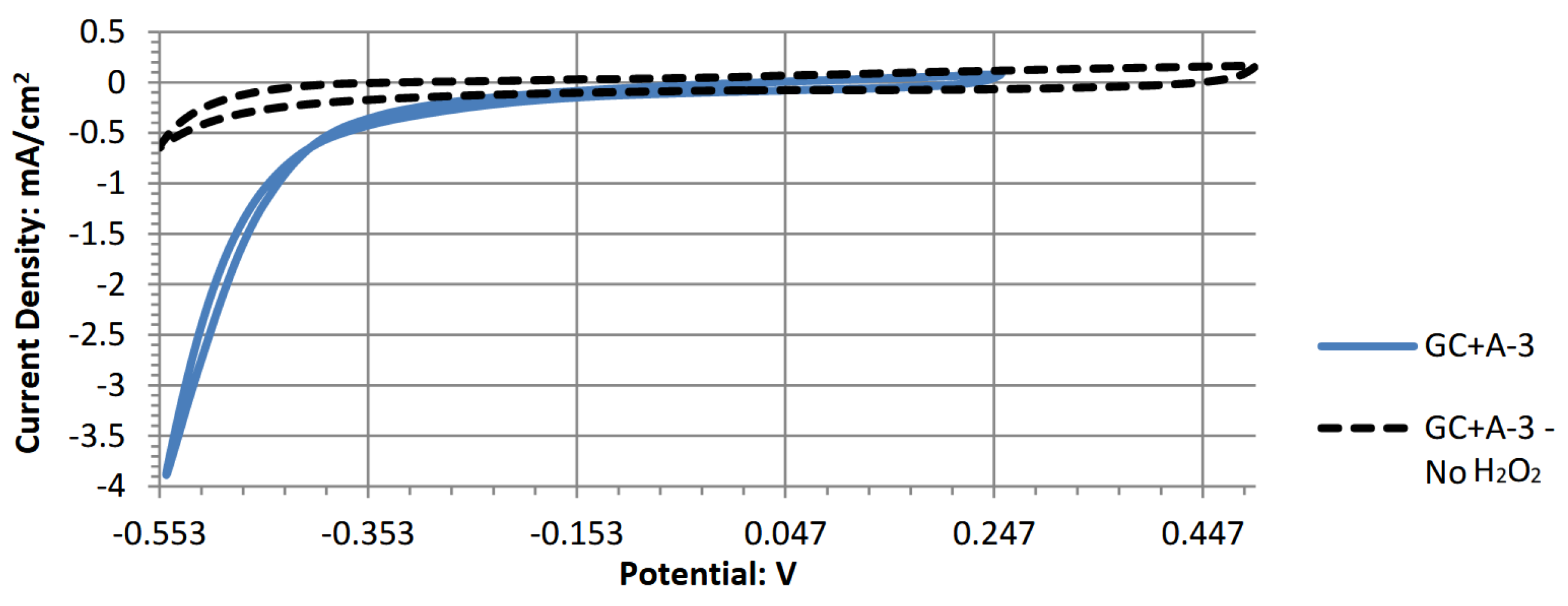
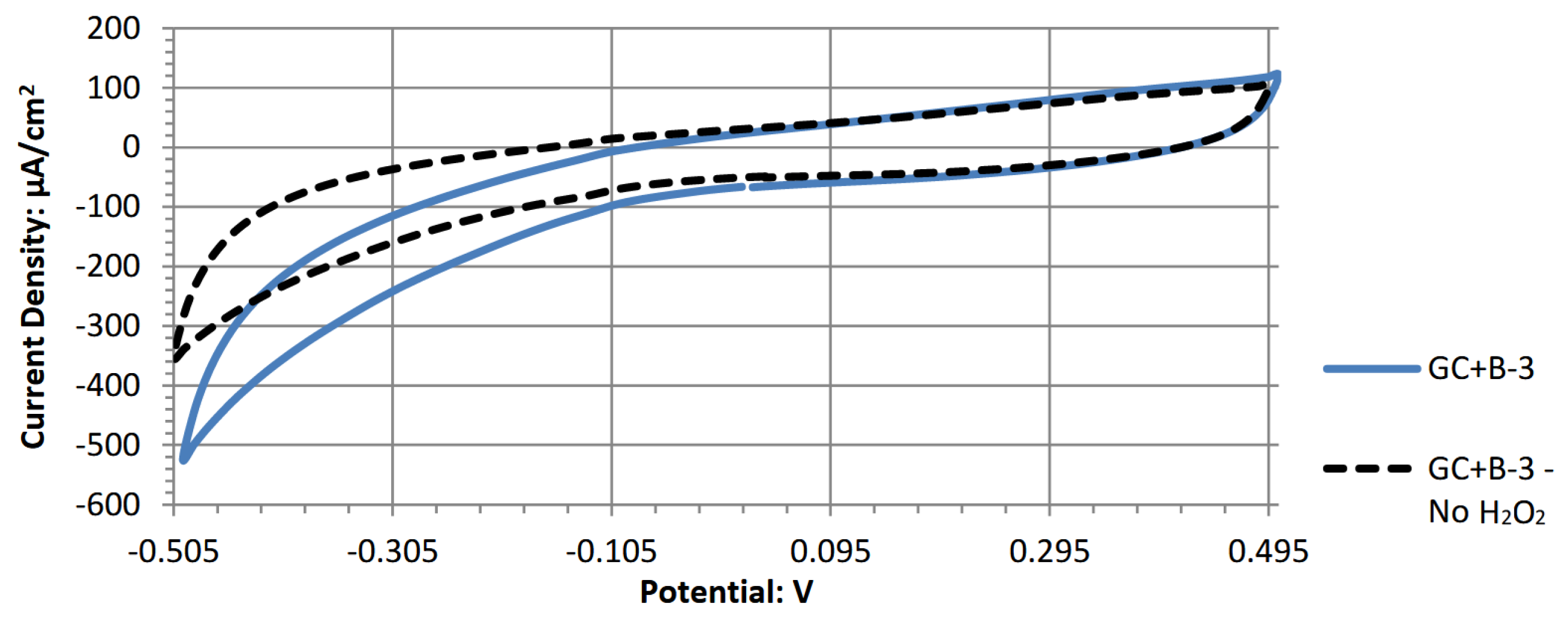

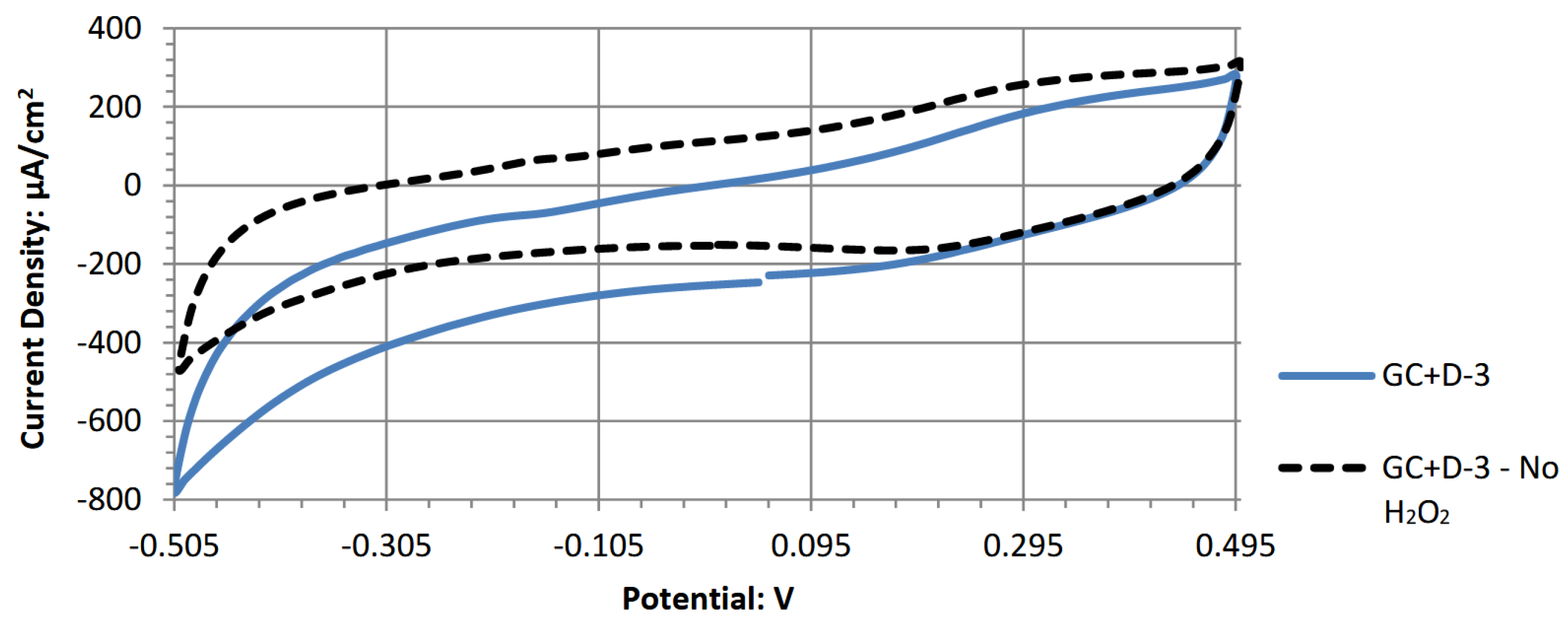
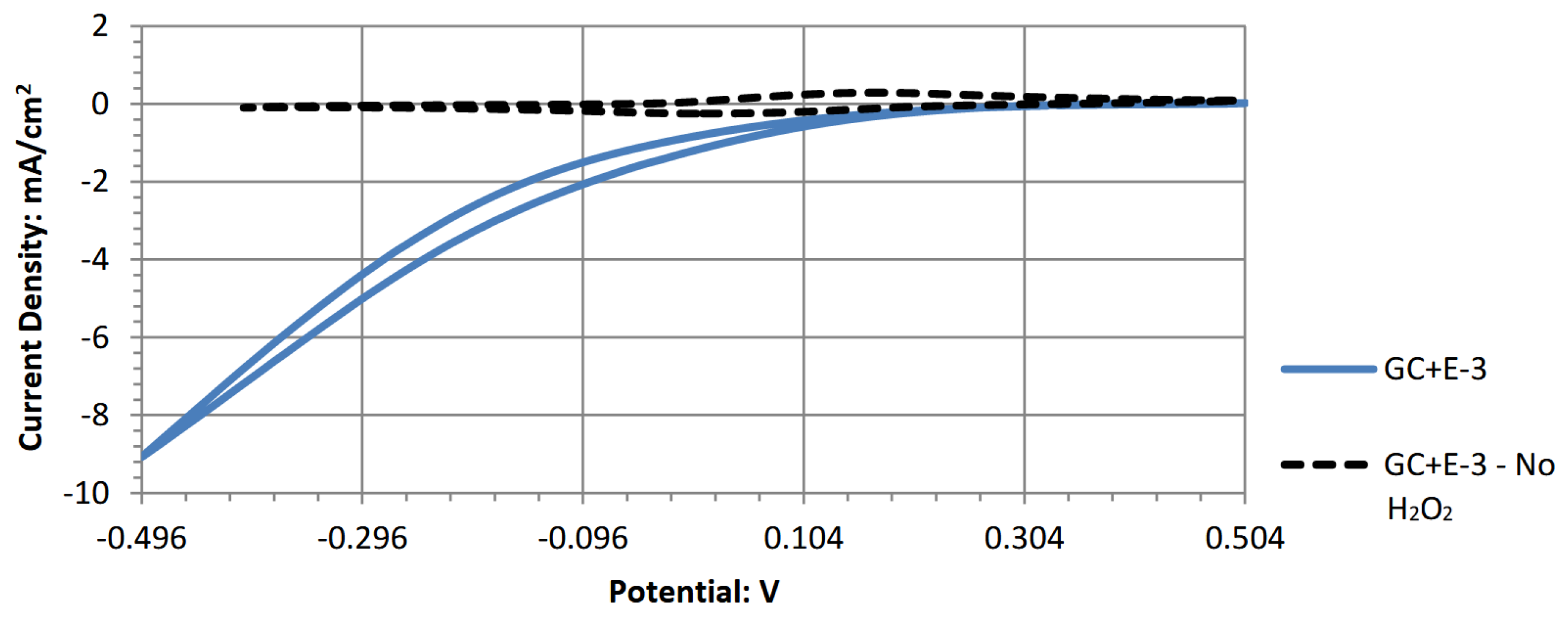
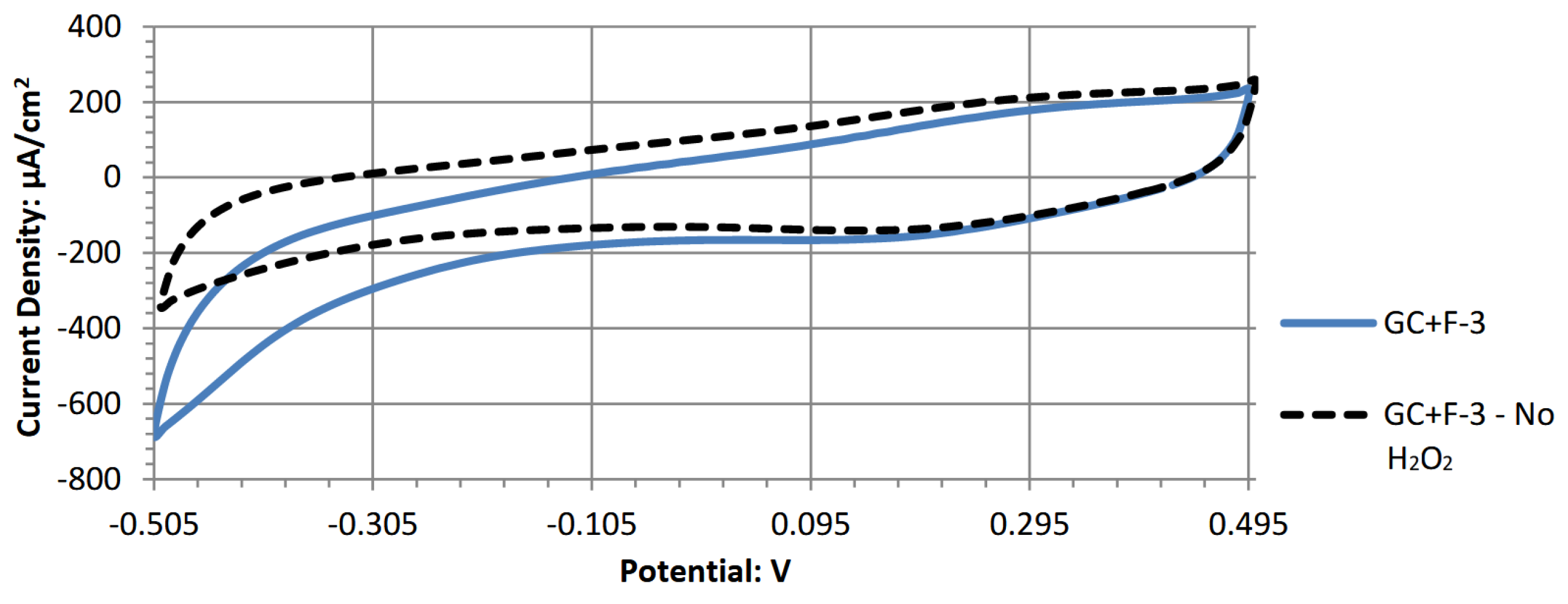
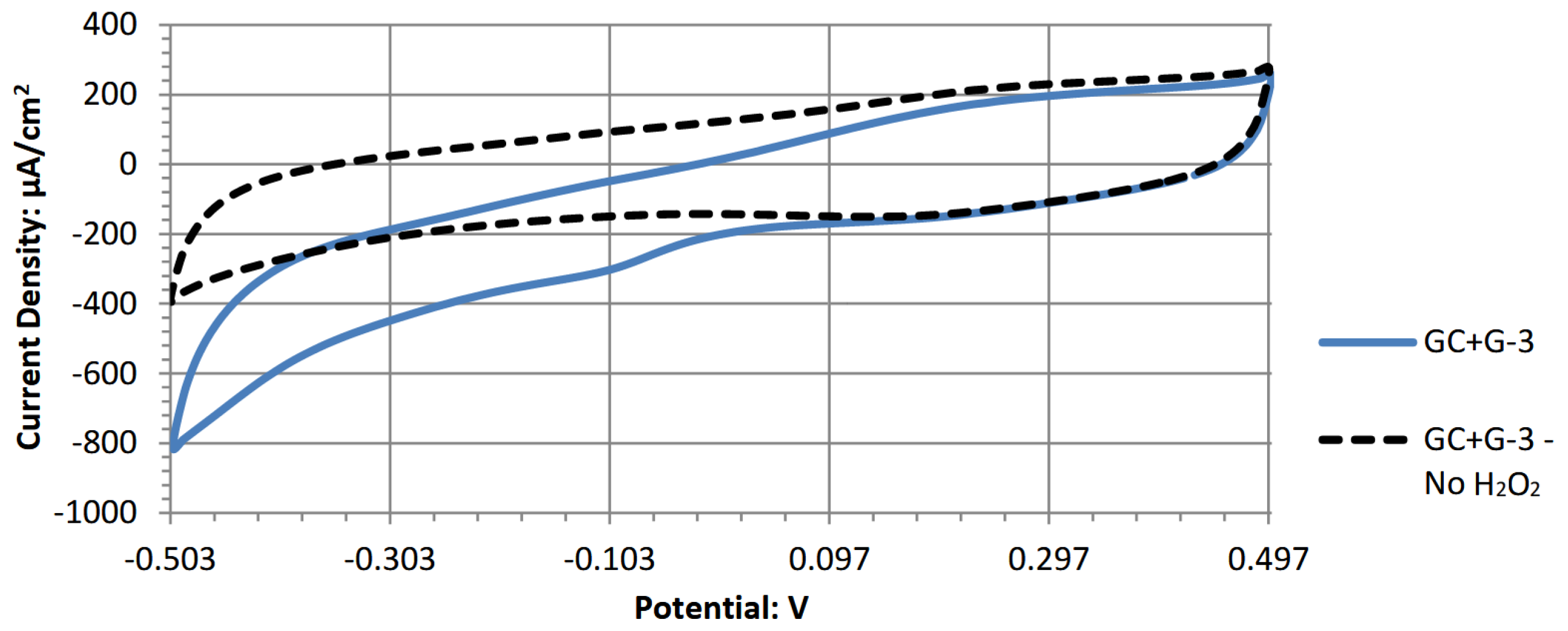

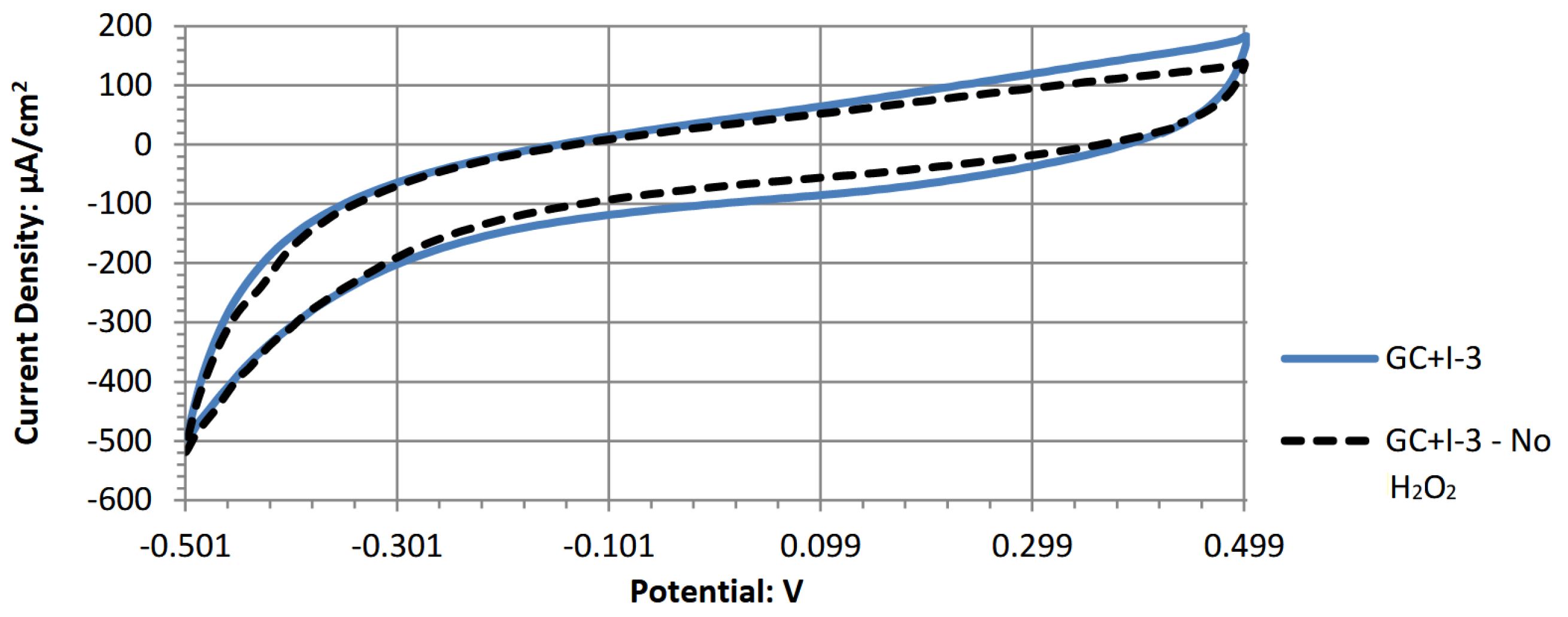
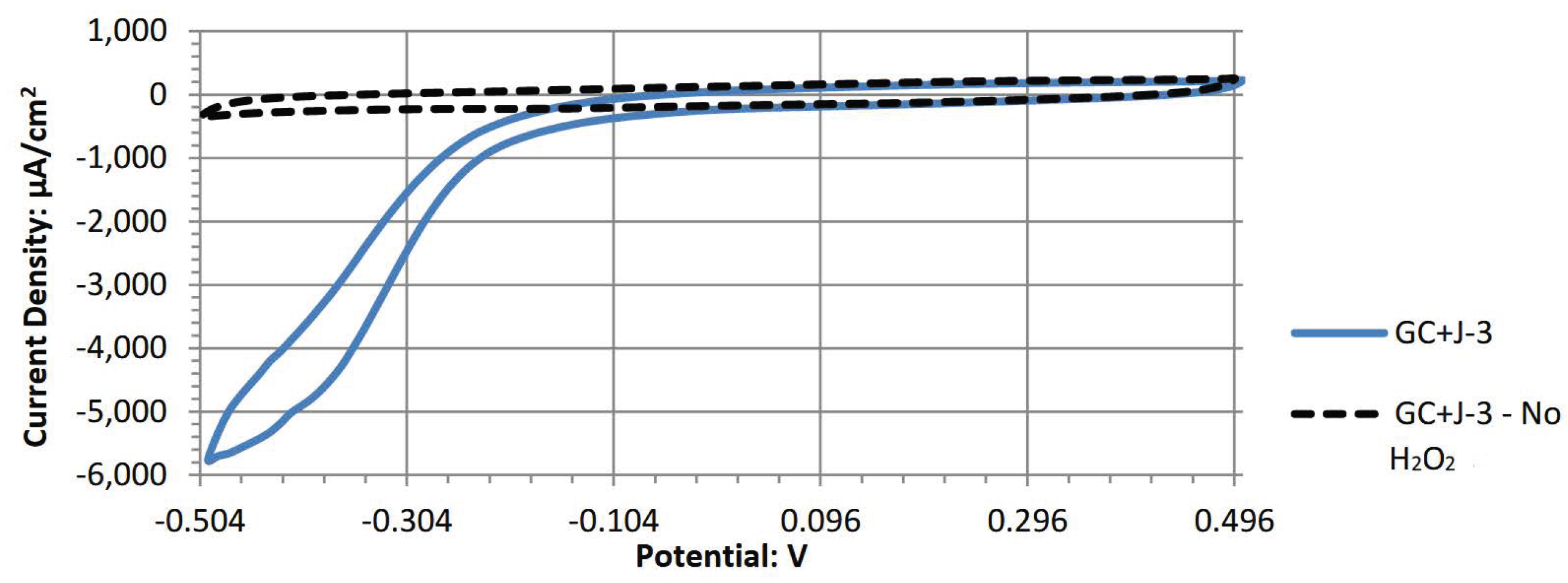
References
- Mekhilef, S.; Saidur, R.; Safari, A. Comparative Study of Different Fuel Cell Technologies. Renew. Sustain. Energy Rev. 2012, 16, 981–989. [Google Scholar] [CrossRef]
- Alderson, F.A. Investigation and Advancement of Novel Single Compartment Hydrogen Peroxide Fuel Cells. Ph.D. Thesis, University of Guelph, Guelph, ON, Canada, 2023. [Google Scholar]
- An, L.; Zhao, T.; Yan, X.; Zhou, X.; Tan, P. The Dual Role of Hydrogen Peroxide in Fuel Cells. Sci. Bull. 2015, 60, 55–64. [Google Scholar] [CrossRef]
- Mellor, D.P. CHAPTER 1—Historical Background and Fundamental Concepts. In Chelating Agents and Metal Chelates; Dwyer, F.P., Mellor, D.P., Eds.; Academic Press: Cambridge, MA, USA, 1964; pp. 1–50. [Google Scholar] [CrossRef]
- Flora, G.; Mittal, M.; Flora, S.J.S. 26—Medical Countermeasures—Chelation Therapy. In Handbook of Arsenic Toxicology; Flora, S.J.S., Ed.; Academic Press: Oxford, UK, 2015; pp. 589–626. [Google Scholar] [CrossRef]
- Gerhardsson, L.; Kazantzis, G. Chapter 23—Diagnosis and Treatment of Metal Poisoning: General Aspects. In Handbook on the Toxicology of Metals, 4th ed.; Nordberg, G.F., Fowler, B.A., Nordberg, M., Eds.; Academic Press: San Diego, CA, USA, 2015; pp. 487–505. [Google Scholar] [CrossRef]
- Darby, R.; Yamana, M.; Dhar, H.; White, R. Metal Chelate Catalysts for Fuel Cells; Final Report, June 1979–October 1982; Texas A&M University, Department of Chemical Engineering: College Station, TX, USA, 1982. [Google Scholar]
- Nguyen, M.T.; Mecheri, B.; D’Epifanio, A.; Sciarria, T.P.; Adani, F.; Licoccia, S. Iron Chelates as Low-Cost and Effective Electrocatalyst for Oxygen Reduction Reaction in Microbial Fuel Cells. Int. J. Hydrogen Energy 2014, 39, 6462–6469. [Google Scholar] [CrossRef]
- Loukanov, A.; Angelov, A.; Takahashi, Y.; Nikolov, I.; Nakabayashi, S. Carbon Nanodots Chelated with Metal Ions as Efficient Electrocatalysts for Enhancing Performance of Microbial Fuel Cell Based on Sulfate Reducing Bacteria. Colloids Surf. Physicochem. Eng. Asp. 2019, 574, 52–61. [Google Scholar] [CrossRef]
- Abdulrahman Hamad, O.; Kareem, R.O.; Khdir Omer, P. Recent Developments in Synthesize, Properties, Characterization, and Application of Phthalocyanine and Metal Phthalocyanine. J. Chem. Rev. 2024, 6, 39–75. [Google Scholar] [CrossRef]
- Martell, A.E. Catalytic Effects of Metal Chelate Compounds. Pure Appl. Chem. 1968, 17, 129–178. [Google Scholar] [CrossRef]
- Kojima, T. Overview of the Catalytic Chemistry of Metal Complexes. In Redox-Based Catalytic Chemistry of Transition Metal Complexes; Kojima, T., Ed.; Royal Society of Chemistry: London, UK, 2024; Volume 2. [Google Scholar] [CrossRef]
- Shaegh, S.A.M.; Nguyen, N.T.; Ehteshami, S.M.M.; Chan, S.H. A Membraneless Hydrogen Peroxide Fuel Cell Using Prussian Blue as Cathode Material. Energy Environ. Sci. 2012, 5, 8225–8228. [Google Scholar] [CrossRef]
- Yamada, Y.; Yoneda, M.; Fukuzumi, S. A Robust One-Compartment Fuel Cell with a Polynuclear Cyanide Complex as a Cathode for Utilizing H2O2 as a Sustainable Fuel at Ambient Conditions. Chem. Eur. J. 2013, 19, 11733–11741. [Google Scholar] [CrossRef]
- Nguyen, B.; Kuperman, N.; Goncher, G.; Solanki, R. Membraneless H2O2 Fuel Cells Driven by Metallophthalocyanine Electrocatalysts. ECS J. Solid State Sci. Technol. 2020, 9, 061009. [Google Scholar] [CrossRef]
- Martins, R.F.; Martins, D.A.A.; Costa, L.A.C.; Matencio, T.; Paniago, R.M.; Montoro, L.A. Copper Hexacyanoferrate as Cathode Material for Hydrogen Peroxide Fuel Cell. Int. J. Hydrogen Energy 2020, 45, 25708–25718. [Google Scholar] [CrossRef]
- Devassy, A.M.C.; Wankhede, K.D.; Kamalakshan, A.; Mandal, S. A Robust Single Compartment Peroxide Fuel Cell Using Mesoporous Antimony Doped Tin Oxide as the Cathode Material. Nanoscale 2024, 16, 12060–12070. [Google Scholar] [CrossRef] [PubMed]
- Miao, Z.; Wang, R.; Li, X.; Sun, F.; Ge, M.; Huang, N.; Zhao, Y.; Chang, Z.; Wang, H. Photoreduced Ag Nanoparticles-Decorated BiVO4 Nanoplates as Photoanode Boosting Photoelectrochemical H2O2 Fuel Cell Performance. J. Power Sources 2025, 629, 235998. [Google Scholar] [CrossRef]
- Zhu, F.; Kuzin, A.; Chen, G.; Gorin, D.A.; Mohan, B.; Huang, G.; Zhao, S.; Mei, Y.; Solovev, A.A. Green Energy for Autonomous Devices: Surfactant-Enhanced Membraneless Hydrogen Peroxide Fuel Cells. In Proceedings of the 2023 International Conference on Manipulation, Automation and Robotics at Small Scales (MARSS), Abu Dhabi, United Arab Emirates, 9–13 October 2023; pp. 1–6. [Google Scholar] [CrossRef]
- Ghani, F.; Kristen, J.; Riegler, H. Solubility Properties of Unsubstituted Metal Phthalocyanines in Different Types of Solvents. J. Chem. Eng. Data 2012, 57, 439–449. [Google Scholar] [CrossRef]
- Paredes, J.I.; Villar-Rodil, S.; Martínez-Alonso, A.; Tascón, J.M.D. Graphene Oxide Dispersions in Organic Solvents. Langmuir 2008, 24, 10560–10564. [Google Scholar] [CrossRef]
- Sargent, M.; Dean, F. Furans and Their Benzo Derivatives: (Ii) Reactivity. In Comprehensive Heterocyclic Chemistry; Elsevier: Amsterdam, The Netherlands, 1984; pp. 599–656. [Google Scholar] [CrossRef]
- Heravi, M.M.; Ghavidel, M.; Mohammadkhani, L. Beyond a Solvent: Triple Roles of Dimethylformamide in Organic Chemistry. RSC Adv. 2018, 8, 27832–27862. [Google Scholar] [CrossRef]
- Monteiro, I.F.; Pinto, R.S.; Silva, M.M.; Fidalgo-Marijuan, A.; Costa, C.M.; Lanceros-Méndez, S.; Gonçalves, R. Lithium-Ion Battery High Performance Cathode Electrode Based on LiFePO4 and Thermal Sensitive Microspheres with Thermal Shutdown Properties. J. Power Sources 2024, 614, 234956. [Google Scholar] [CrossRef]
- Yamada, Y.; Yoshida, S.; Honda, T.; Fukuzumi, S. Protonated Iron–Phthalocyanine Complex Used for Cathode Material of a Hydrogen Peroxide Fuel Cell Operated under Acidic Conditions. Energy Environ. Sci. 2011, 4, 2822–2825. [Google Scholar] [CrossRef]
- Ramkumar, J. Metal Ion Uptake Behaviour of Nafion in Presence of Organic Complexing Reagents. Moj Bioorg. Org. Chem. 2017, 1, 1–3. [Google Scholar] [CrossRef]
- Pruckmayr, G.; Wu, T.K. Polymerization of Tetrahydrofuran by Proton Acids. Macromolecules 1978, 11, 662–668. [Google Scholar] [CrossRef]
- Meeussen, J.C.L.; Keizer, M.G.; Van Riemsdijk, W.H.; De Haan, F.A.M. Dissolution Behavior of Iron Cyanide (Prussian Blue) in Contaminated Soils. Environ. Sci. Technol. 1992, 26, 1832–1838. [Google Scholar] [CrossRef]
- Lo, P.C.; Leng, X.; Ng, D.K.P. Hetero-Arrays of Porphyrins and Phthalocyanines. Coord. Chem. Rev. 2007, 251, 2334–2353. [Google Scholar] [CrossRef]
- Alderson, F.; Appuhamy, R.; Gadsden, S.A. Investigation of Select Pure Earth Metals as Redox Catalytic Electrodes in Single Compartment Hydrogen Peroxide Fuel Cells. Appl. Sci. 2025, 15, 1857. [Google Scholar] [CrossRef]
- Aoki, K.J.; Chen, J.; Aoki, K.J.; Chen, J. Tips of Voltammetry. In Voltammetry; IntechOpen: London, UK, 2018. [Google Scholar] [CrossRef]
- Luo, C.; Xie, H.; Wang, Q.; Luo, G.; Liu, C. A Review of the Application and Performance of Carbon Nanotubes in Fuel Cells. J. Nanomater. 2015, 2015, 560392. [Google Scholar] [CrossRef]

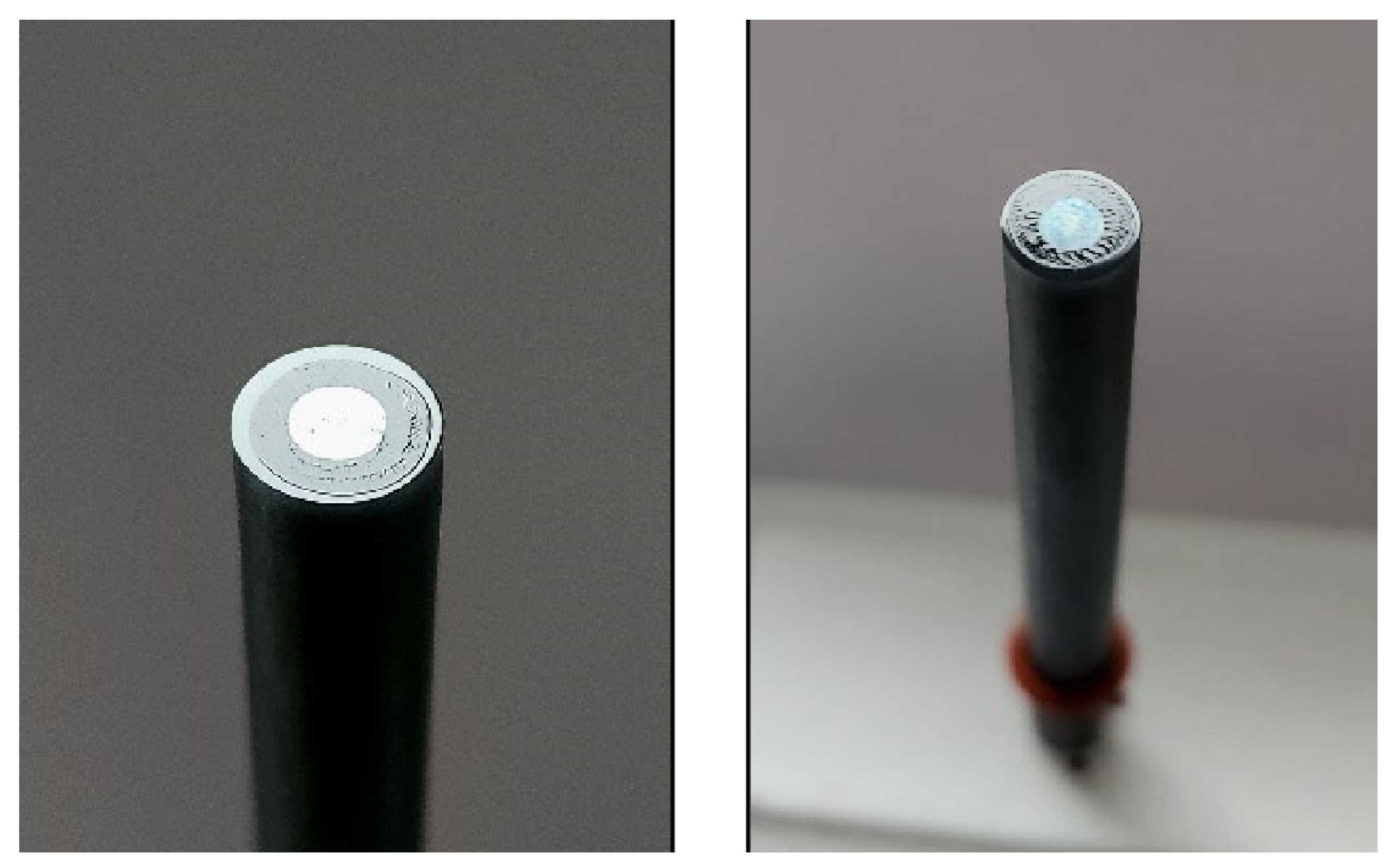


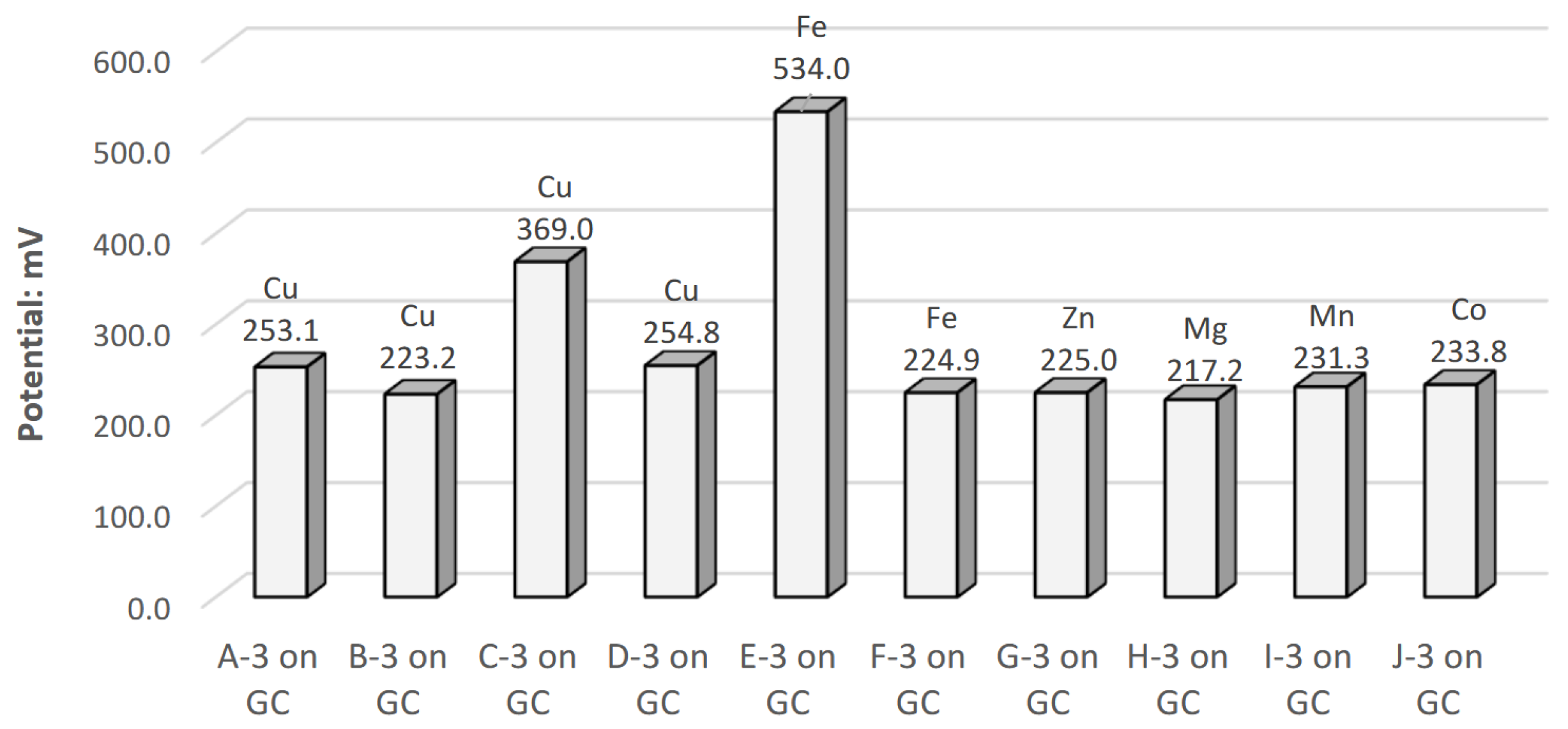
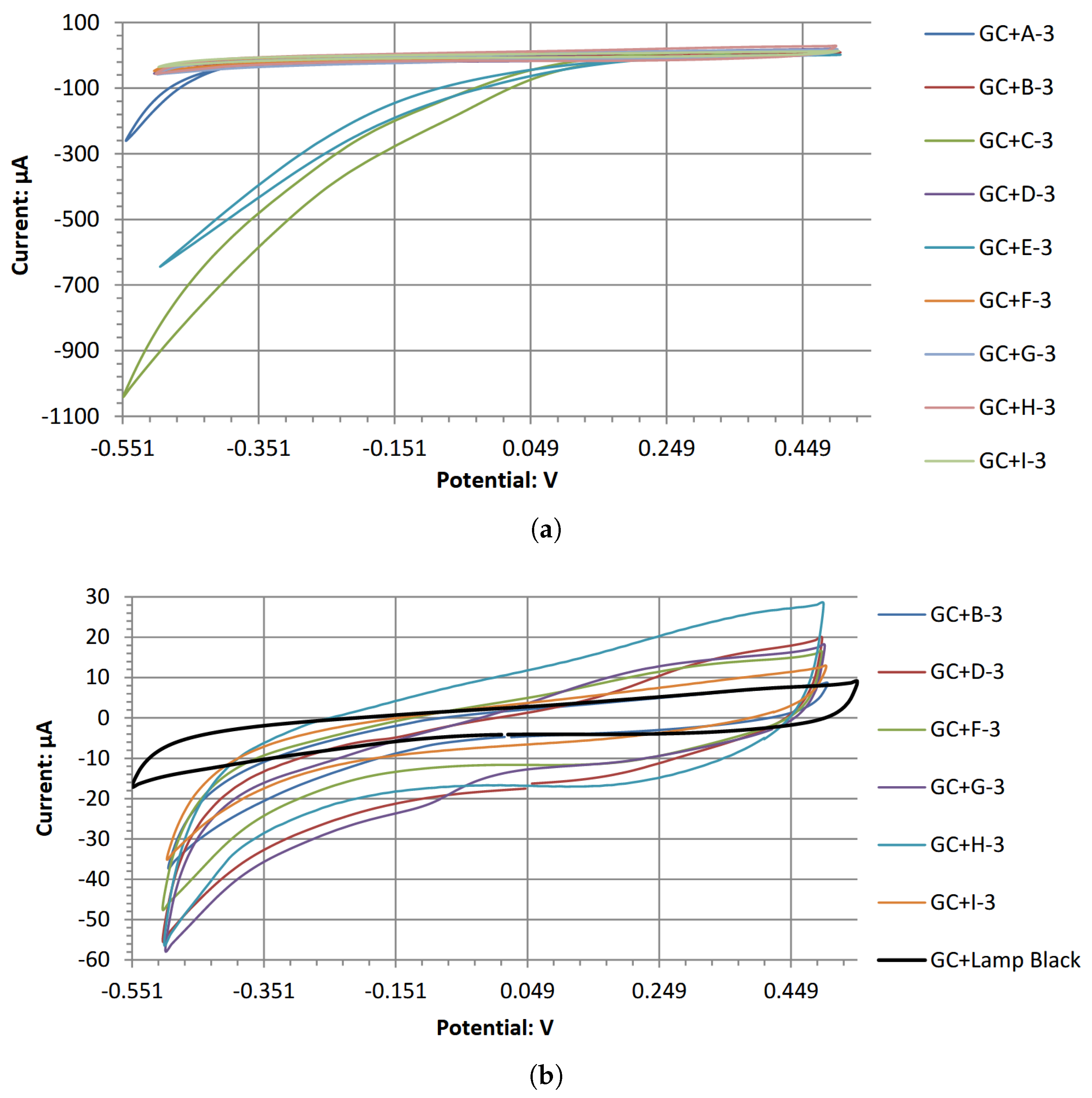
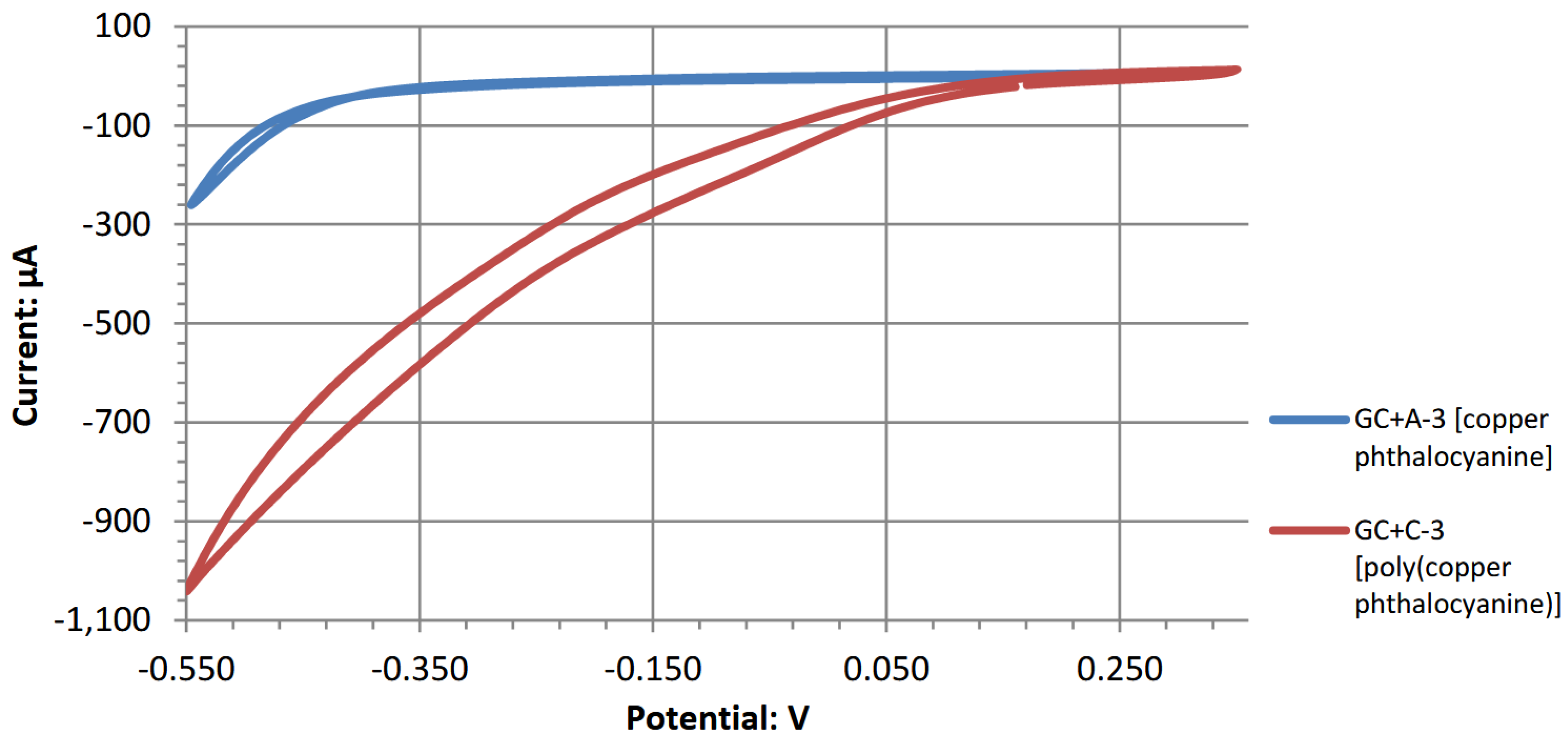
| Compound/Material | Source | Purity | CAS # |
|---|---|---|---|
| Ag/AgCl (3 M NaCl) reference electrode | BASi Research Products (West Lafayette, IN, USA) | N/A | N/A |
| Bis(ethylenediamine)copper(II) hydroxide | Millipore Sigma (Burlington, VT, USA) | 1 Molar | 14552-35-3 |
| Cobalt (II) phthalocyanine | Millipore Sigma (Burlington, VT, USA) | 97% | 3317-67-7 |
| Copper (II) phthalocyanine | Millipore Sigma (Burlington, VT, USA) | 90% | 147-14-8 |
| Copper hexadecachlorophthalocyanine (phthalocyanine green) | Millipore Sigma (Burlington, VT, USA) | Not disclosed | 14832-14-5 |
| Dichloromethane (DCM) | Millipore Sigma (Burlington, VT, USA) | 99.8% | 1975-09-02 |
| Dimethylformamide (DMF) | Millipore Sigma (Burlington, VT, USA) | 99.9% | 1968-12-02 |
| Glassy carbon electrode (3.0 mm diameter) | BASi Research Products (West Lafayette, IN, USA) | N/A | N/A |
| Graphene oxide decorated with iron oxide (containing both Fe2+ and Fe3+ ions) | Abalonyx Innovative Materials (Oslo, Norway) | Not disclosed | N/A |
| Hydrochloric acid | Millipore Sigma (Burlington, VT, USA) | 37% | 7647-01-0 |
| Hydrogen peroxide (industrial grade) | Arkema (Columbes, France) | 50% | 7722-84-1 |
| Iron(III) ferrocyanine (Prussian blue) | Millipore Sigma (Burlington, VT, USA) | Not disclosed | 14038-43-8 |
| Isopropanol | VWR (Radnor, PA, USA) | 70% | 67-63-0 |
| Magnesium phthalocyanine | Millipore Sigma (Burlington, VT, USA) | 90% | 1661-03-6 |
| Manganese(II) phthalocyanine | Millipore Sigma (Burlington, VT, USA) | 100% | 14325-24-7 |
| Microfiber cloth | Fosmon (Woodbury, NY, USA) | N/A | N/A |
| Nafion™ 117 | Millipore Sigma (Burlington, VT, USA) | 5% | 31175-20-9 |
| Platinum wire electrode (MW-1033) | BASi Research Products (West Lafayette, IN, USA) | N/A | N/A |
| Polishing paste, 14,000 grit (1–0.5 µm) | TechDiamondTools (Santa Clara, CA, USA) | N/A | N/A |
| Polishing paste, 5000 grit (2–3 µm) | TechDiamondTools (Santa Clara, CA, USA) | N/A | N/A |
| Polishing paste, 50,000 grit (0.5–0.01 µm) | TechDiamondTools (Santa Clara, CA, USA) | N/A | N/A |
| Poly(copper phthalocyanine) | Millipore Sigma (Burlington, VT, USA) | 60% | 26893-93-6 |
| Reverse-osmosis water (R < 1.3 µs/cm) | High Purity Water Service (Oakville, ON, Canada) | 100% | 7732-18-5 |
| Sodium chloride | Millipore Sigma (Burlington, VT, USA) | 99.50% | 7647-14-5 |
| Tetrahydrofurane (THF) | Millipore Sigma (Burlington, VT, USA) | 99.9% | 109-99-9 |
| Trifluoroacetic acid (TFA) | Millipore Sigma (Burlington, VT, USA) | 99% | 1976-05-01 |
| Zinc phthalocyanine | Millipore Sigma (Burlington, VT, USA) | 97% | 14320-04-8 |
| Applied Potential Resolution (µV) | Applied Potential Accuracy (mV) | Measured Currency Resolution | Measured Current Accuracy (pA) | |
|---|---|---|---|---|
| EmStat4S | 100 | ≤ | of CR | <0.2% of current |
| Aliquot | Chelated Metal Complex (CMC) | CMC Amount (mg) | THF (mL) | 5% Nafion in MeOH (mL) |
|---|---|---|---|---|
| A | Copper (II) phthalocyanine | 0.6 | 0.8 | 0.2 |
| B | Phthalocyanine green | 0.6 | 0.8 | 0.2 |
| C | Poly(copper phthalocyanine) | 0.6 | 0.8 | 0.2 |
| D | Bis(ethylene-diamine)copper (II) hydroxide | 2.8 | 0.8 70% IPA | 0.2 |
| E | Iron (III) ferrocyanine | 0.6 | 0.8 | 0.2 |
| F | Graphene oxide decorated with Fe304 | 0.6 | 0.8 | 0.2 |
| G | Zinc phthalocyanine | 0.6 | 0.8 | 0.2 |
| H | Magnesium phthalocyanine | 0.6 | 0.8 | 0.2 |
| I | Manganese (II) phthalocyanine | 0.6 | 0.8 | 0.2 |
| J | Cobalt (II) phthalocyanine | 0.6 | 0.8 | 0.2 |
| Aliquot | Stock (µL) | Lampblack Carbon (mg) |
|---|---|---|
| A-3 | 100 of A-2 | 0.05 |
| B-3 | 100 of B-2 | 0.05 |
| C-3 | 100 of C-2 | 0.05 |
| D-3 | 100 of D-2 | 0.05 |
| E-3 | 100 of E-2 | - |
| F-3 | 100 of F-2 | 0.05 |
| G-3 | 100 of G-2 | 0.05 |
| H-3 | 100 of H-2 | 0.05 |
| I-3 | 100 of I-2 | 0.05 |
| J-3 | 100 of J-2 | 0.05 |
| Ag (mV) | Pt (mV) | Sb (mV) | Ta (mV) | |
|---|---|---|---|---|
| A-2 on GC | −418 | 36 | −335 | −384 |
| B-2 on GC | −430 | 22 | −372 | −412 |
| C-2 on GC | −634 | −18 | −498 | −545 |
| D-2 on GC | −530 | 9 | −436 | −490 |
| E-2 on GC | −627 | −85 | −618 | −600 |
| F-2 on GC | −598 | −21 | −497 | −555 |
| G-2 on GC | −591 | −32 | −440 | −361 |
| H-2 on GC | −612 | −43 | −390 | −433 |
| I-2 on GC | −428 | 48 | −366 | −443 |
| J-2 on GC | −522 | 63 | −410 | −460 |
| Bare GC | −370 | 40 | −295 | −340 |
| Electrode | Peak Power Density—Acidic Electrolyte (µW/cm2 @ V) (pH 1.08, 0.5 M H2O2) |
|---|---|
| A-3 on GC | 2121.46 @ 0.546 |
| B-3 on GC | 260.12 @ 0.496 |
| C-3 on GC | 7923.81 @ 0.540 |
| D-3 on GC | 392.40 @ 0.504 |
| E-3 on GC | 4500.86 @ 0.496 |
| F-3 on GC | 344.99 @ 0.505 |
| G-3 on GC | 406.51 @ 0.501 |
| H-3 on GC | 411.30 @ 0.502 |
| I-3 on GC | 245.78 @ 0.498 |
| J-3 on GC | 2857.67 @ 0.496 |
Disclaimer/Publisher’s Note: The statements, opinions and data contained in all publications are solely those of the individual author(s) and contributor(s) and not of MDPI and/or the editor(s). MDPI and/or the editor(s) disclaim responsibility for any injury to people or property resulting from any ideas, methods, instructions or products referred to in the content. |
© 2025 by the authors. Licensee MDPI, Basel, Switzerland. This article is an open access article distributed under the terms and conditions of the Creative Commons Attribution (CC BY) license (https://creativecommons.org/licenses/by/4.0/).
Share and Cite
Alderson, F.; Appuhamy, R.; Gadsden, S.A. Evaluating Performance of Metal-Organic Complexes as Electrodes in Hydrogen Peroxide Fuel Cells. Energies 2025, 18, 2598. https://doi.org/10.3390/en18102598
Alderson F, Appuhamy R, Gadsden SA. Evaluating Performance of Metal-Organic Complexes as Electrodes in Hydrogen Peroxide Fuel Cells. Energies. 2025; 18(10):2598. https://doi.org/10.3390/en18102598
Chicago/Turabian StyleAlderson, Faraz, Raveen Appuhamy, and Stephen Andrew Gadsden. 2025. "Evaluating Performance of Metal-Organic Complexes as Electrodes in Hydrogen Peroxide Fuel Cells" Energies 18, no. 10: 2598. https://doi.org/10.3390/en18102598
APA StyleAlderson, F., Appuhamy, R., & Gadsden, S. A. (2025). Evaluating Performance of Metal-Organic Complexes as Electrodes in Hydrogen Peroxide Fuel Cells. Energies, 18(10), 2598. https://doi.org/10.3390/en18102598






